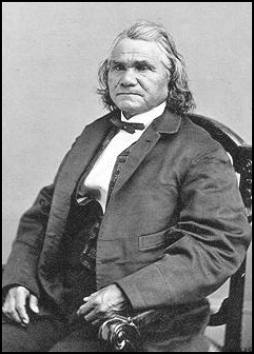|
GENERAL STAND WATIE'S REGIMENT
(First Regiment of Cherokee Mounted Volunteers)
| Cherokee Mounted Volunteers |

|
| Brigadier General Stand Watie |
Confederate officials commissioned Stand Watie a colonel in the Confederate States
Army in July 1861 and authorized him to raise the First Regiment of Cherokee Mounted Volunteers. Cherokee Chief John Ross signed the Cherokee-Confederate treaty of alliance in October 1861 and raised the First Regiment of Cherokee Mounted
Rifles, commanded by Col. John Drew. At this time, Watie's regiment became the Second Regiment of Cherokee Mounted Rifles.
A portion of Drew's regiment deserted in late 1861. Following the Battle of Fort
Wayne in October 1862, most of the remainder of Drew's men deserted. What remained of his troops was combined with Watie's
regiment and reorganized as the First Regiment of Cherokee Mounted Rifles with Watie in command.
During the Civil War, Watie's troops participated in twenty-seven major engagements
and numerous skirmishes. Although some of the engagements were set-piece battles, most of his activities utilized guerrilla warfare and tactics. Watie's men launched raids from south of the Canadian River throughout northern-held Indian Territory and into Kansas and
Missouri, tying down thousands of Union troops. Poorly equipped and armed mostly with castoff rifles or captured weapons,
the Cherokees were well suited to this type of warfare. Watie was promoted to brigadier general in May 1864.
Watie's most spectacular victories included the capture of a Federal steamboat, the
J. R. Williams, in June 1864 and the capture of a Union wagon train at the Second Battle of Cabin Creek in September 1864.
His three most infamous actions were the burning of Rose Cottage, home of Chief John Ross, and the Cherokee Council House
in October 1863, and the massacre of the First Kansas Colored Infantry and Second Kansas Cavalry at the Hay Meadow fight in
September 1864.
In February 1865, Watie was given command of the Indian Division of Indian Territory
but was unable to launch any offensive operations. He released most of his troops following the collapse of Confederate resistance
in the spring of 1865. After participating in the Camp Napoleon Council in May, Stand Watie officially surrendered on June
23, 1865, becoming the last Confederate general to lay down his arms.
BIBLIOGRAPHY: Edward E. Dale and Gaston Litton, ed., Cherokee
Cavaliers: Forty Years of Cherokee History as Told in the Correspondence of the Ridge-Watie-Boudinot Family (Norman: University
of Oklahoma Press, 1939). Kenny A. Franks, Stand Watie and the Agony of the Cherokee Nation (Memphis, Tenn.: Memphis
State University Press, 1979). Grace Steele Woodward, The Cherokees (Norman: University of Oklahoma Press, 1963). Kenny
A. Franks, © Oklahoma Historical Society.
Recommended Reading: Rifles for Watie. Description: This is a rich and sweeping novel-rich in its panorama of history; in its details so
clear that the reader never doubts for a moment that he is there; in its dozens of different people, each one fully realized
and wholly recognizable. It is a story of a lesser -- known part of the Civil War, the Western campaign, a part different
in its issues and its problems, and fought with a different savagery. Inexorably it moves to a dramatic climax, evoking a
brilliant picture of a war and the men of both sides who fought in it.
Recommended: General Stand Watie's
Confederate Indians (University of Oklahoma
Press). Description: American Indians were courted by both the North and the South
prior to that great and horrific conflict known as the American Civil War. This is the story of the highest ranking Native
American--Cherokee chief and Confederate general--Stand Watie, his Cherokee Fighting
Unit, the Cherokee, and the conflict in the West.
Highly
Recommended Viewing: Indian Warriors - The Untold Story of the Civil
War (History Channel) (2007). Description: Though
largely forgotten, 20 to 30 thousand Native Americans fought in the Civil War. Ely Parker was a Seneca leader who found himself
in the thick of battle under the command of General Ulysses S. Grant. Stand Waite--a
Confederate general and a Cherokee--was known for his brilliant guerrilla tactics. Continued...
Also highlighted
is Henry Berry Lowery, an Eastern North Carolina Indian, who became known as the Robin Hood of North Carolina. Respected Civil
War authors, Thom Hatch and Lawrence Hauptman, help reconstruct these most captivating stories, along with descendants like
Cherokee Nation member Jay Hanna, whose great-grandfathers fought for both the Union and the Confederacy. Together, they reveal a new, fresh perspective and the very
personal reasons that drew these Native Americans into the fray.
Also
consider: Civil
War Terror (History Channel) Description: This is the
largely untold story of a war waged by secret agents and spies on both sides of the Mason Dixon Line. These are tales of hidden
conspiracies of terror that specifically targeted the civilian populations. Engineers of chemical weapons, new-fangled explosives
and biological warfare competed to topple their enemy. Continued below...
With insight from Civil War authorities, we debunk the long-held image of a romantic and gentlemanly war.
To revisit the past, we incorporate written sources, archival photographs and newspaper headlines. Our reenactments bring
to life key moments in our historical characters' lives and in each of the horrific terrorist plots.
Try the Search Engine for Related
Studies: First Regiment of Cherokee Mounted Volunteers, 1st Regiment of Cherokee Volunteers, Cherokee Braves,
Second Regiment of Cherokee Volunteers, 2nd Regiment Cherokee Indians American Civil War History
|

